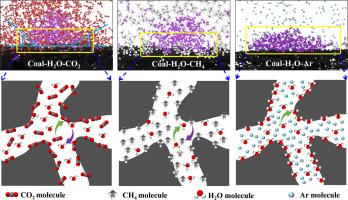Wettability of the coal–water–Ar interface under coupled temperature and pressure conditions
IF 6.3
2区 材料科学
Q2 CHEMISTRY, PHYSICAL
引用次数: 0
Abstract
Coal wettability plays a critical role in a wide range of engineering applications, including mine disaster prevention, coalbed methane recovery, mineral flotation, and CO₂ geological sequestration. However, the mechanisms by which temperature and pressure affect wettability at the coal–water–gas interface remain inadequately understood. In this study, we systematically investigated the variations in surface tension of aqueous solutions and coal–water contact angles under an inert argon Ar atmosphere using a dedicated wettability testing system, in combination with molecular dynamics (MD) simulations to uncover the underlying microscopic mechanisms. Experimental results revealed that increasing temperature and Ar pressure led to a gradual decline in both water surface tension and coal–water contact angle. Despite this trend, the overall changes were relatively modest, indicating that coal wettability remains largely stable under such conditions. MD simulations further demonstrated that temperature and Ar pressure exert only minor influences on simulated contact angles, coal–water interaction energies, hydrogen bond numbers, diffusion coefficients of water molecules, and their relative concentration distributions. At the molecular level, elevated temperatures were found to promote water spreading on the coal surface, whereas increased Ar pressure slightly inhibited this behavior. Moreover, the contrasting impacts of adsorptive versus non-adsorptive gases on coal surface wettability were explored. Collectively, these findings provide critical insights into the macro- and microscopic wetting behavior at coal–water interfaces under complex thermodynamic conditions, offering theoretical guidance for the efficient and environmentally sustainable utilization of coal resources.

温度和压力耦合条件下煤-水-氩界面的润湿性
煤的润湿性在矿山灾害防治、煤层气回收、矿物浮选、CO 2地质封存等广泛的工程应用中发挥着至关重要的作用。然而,温度和压力对煤-水-气界面润湿性的影响机制尚不清楚。在本研究中,我们利用专用的润湿性测试系统,结合分子动力学(MD)模拟,系统地研究了惰性氩氩气氛下水溶液表面张力和煤水接触角的变化,以揭示潜在的微观机制。实验结果表明,温度和氩气压力的升高导致水表面张力和水煤接触角逐渐减小。尽管有这种趋势,但总体变化相对温和,表明在这种条件下煤的润湿性基本保持稳定。MD模拟进一步表明,温度和氩气压力对模拟的接触角、水煤相互作用能、氢键数、水分子扩散系数及其相对浓度分布的影响较小。在分子水平上,升高的温度促进了水在煤表面的扩散,而增加的氩气压力则略微抑制了这种行为。此外,还探讨了吸附气体和非吸附气体对煤表面润湿性的影响。总的来说,这些发现为复杂热力学条件下煤-水界面的宏观和微观润湿行为提供了重要的见解,为煤炭资源的高效和环境可持续利用提供了理论指导。
本文章由计算机程序翻译,如有差异,请以英文原文为准。
求助全文
约1分钟内获得全文
求助全文
来源期刊

Surfaces and Interfaces
Chemistry-General Chemistry
CiteScore
8.50
自引率
6.50%
发文量
753
审稿时长
35 days
期刊介绍:
The aim of the journal is to provide a respectful outlet for ''sound science'' papers in all research areas on surfaces and interfaces. We define sound science papers as papers that describe new and well-executed research, but that do not necessarily provide brand new insights or are merely a description of research results.
Surfaces and Interfaces publishes research papers in all fields of surface science which may not always find the right home on first submission to our Elsevier sister journals (Applied Surface, Surface and Coatings Technology, Thin Solid Films)
 求助内容:
求助内容: 应助结果提醒方式:
应助结果提醒方式:


